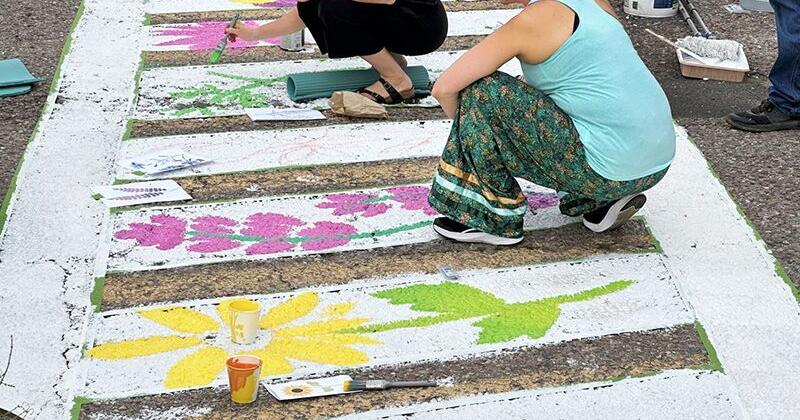ST. IGNATIOUS — Elders on the Flathead Reservation said unsafe crosswalks and fast traffic made it harder to walk, bike, or use wheelchairs in town. Last Wednesday, their concerns began turning into action as partners installed quick-build projects at two intersections in Mission, with additional sites still planned.
The project is a collaboration between the Confederated Salish and Kootenai Tribes (CSKT), CSKT Tribal Health Department, America Walks, and the University of Montana. Quick-builds are low-cost pilot installations that test safer crosswalk designs by narrowing lanes and shortening crossing distances. In Mission, CSKT added artwork to the projects, incorporating flowers, plants, and Salish words into the painted intersections.
Crews installed one project on the road behind Tribal Health and another at the four-way near the Longhouse, which includes four painted crosswalks. Other intersections in town have been identified for similar improvements and are expected to be completed later.
One neighbor who helped with the work and lives along the Longhouse crossing said cars “fly by” her house every day. She worries about children riding bikes in the area. The concern sparked conversations about bringing back bike safety education for kids, since traffic speed makes it too dangerous for them to be riding around the neighborhood on their own.
Traffic speed remains a concern across the reservation, and organizers say these projects are one step toward slowing vehicles and creating safer spaces for people on foot, on bikes, or using wheelchairs.
“We are doing a quick-build project, so we’re doing crosswalk improvements in a couple of different locations here in Saint Ignatius,” said Dr. Samantha Morigeau, a doctor of physical therapy with CSKT. “Older adults on the Flathead Reservation identified things in the community that made it easier or harder to mobilize… one of the things was a lack of crosswalks or poorly maintained crosswalks. And so we partnered with America Walks, and they had funding to do these quick builds.”
Morigeau said the project connects to Tribal Health’s fall prevention programs, where older adults pointed out obstacles like poor lighting, uneven sidewalks, and unsafe crossings. That feedback guided the Mission work.
Maja Pedersen, an assistant professor at the University of Montana’s School of Public and Community Health Sciences, said her team helped gather and organize the concerns. “We asked participants to take photos and record voice memos about pedestrian safety,” she said. “We had a big group of perspectives from five different communities across the reservation, and we asked older adults to prioritize issues that impacted their safety.”
Those priorities translated into visible changes on the ground. Ian Thomas, technical assistance lead with America Walks, said the quick-builds are designed to slow cars and shorten crossings. “We’ve narrowed the lanes, tightened up the intersections, and shortened the distance people have to cross,” Thomas said. “That means drivers have to slow down, and pedestrians have safer spaces while crossing.”
While the quick-builds are meant to test safety designs, in Mission, they also carry a deeper layer of meaning. CSKT’s design team added artwork to the crosswalks, weaving in flowers, landscapes, and Salish words. The painted intersections represent the tribes’ relationship to the land and language while drawing drivers’ eyes to the crossings themselves.
Morigeau said that the combination of culture and safety together reflects what the project is about: putting community voices into action. “We’re putting our community feedback to work,” she said.
The partners say more work is planned, both in Mission and across the reservation, as time and effort allow. For now, the two completed crossings already change the way the streets feel. From the driver’s seat, the bold colors and tighter lanes signal caution. From a pedestrian’s view, they create space to pause and move more confidently.
In Mission, the painted crosswalks are both practical and symbolic: a step toward safer streets, and a reminder that the culture of the Salish, Kootenai, and Pend d’Oreille people continues to guide how this community moves forward.

